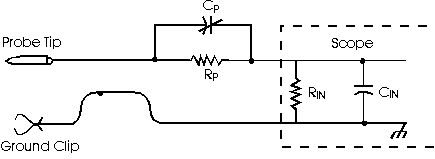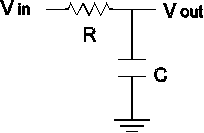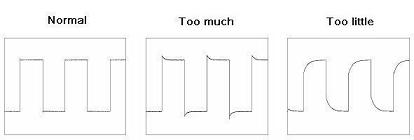| |
Oscilloscope Probes for Accurate Signal Measurements |
|
On the following article learn about Oscilloscope probes, their basic characteristics and proper calibration. Measuring signals with oscilloscopes may be challenging task especially high frequency ones. Without proper oscilloscope probes correct measurement of high speed time domain signals wouldn’t be possible. For high speed measurement you should consider signal parameters like amplitude, source impedance, rise time and bandwidth.

There is a wide variety of probes available – passive, active, current-measurement, optical, high voltage and differential. But let's narrow discussion to probes that are used to measure signals with wide bandwidth and short rise times. There are also many variations on what probe is proper. As probes are potential load to measured circuit, it is important to know its sensitivity to resistive, capacitive or inductive loading. Incorrectly chosen probe (like high capacitance) can distort fast rising signal. Some circuits may not tolerate probes at all (high speed amplifiers).
Sp first of all use two signal parameters for selecting probe – bandwidth and rise time. Generally speaking – scope and probe bandwidth should be three to five times wider than signal's being measured. Select a probe that is at least the same frequency range as the oscilloscope being used. When using a 100MHz oscilloscope, select a minimum of 100 MHz probe. To achieve the optimum performance, choose a probe with more than twice the bandwidth of the oscilloscope.
Probe Bandwidth
It doesn't matter what type of signal is measured it is always important that scope have enough bandwidth to reproduce signal correctly. For analog signals highest frequency will determine the scope bandwidth while in digital signal measurements there is signal rise time important. Like usually bandwidth is determined at -3dB level or 70.7% signal drop level:
20·log(Vout/Vin)=20·log(0.707)=-3dB
To avoid significant measurement errors measurements should never be performed near -3dB bandwidth level. Other wise it may produce up to 30%amplitude error for sine wave. So if 100MHz signal is measured with scope where bandwidth is 100MHz then signal will have about 30% error. So with 100MHz oscilloscope measured signal frequency shouldn't exceed 0.3·100MHz=33.3MHz. For 100MHz signal there is 300MHz bandwidth oscilloscope needed. Probe bandwidth should be at least twice as oscilloscope. This would be 600MHz. Then you should achieve less than 3% error.
For digital signals rise time is important. Rise time determines probe bandwidth. Let's say we use simple RC network probe:
Input signal is voltage step, and then output voltage will be calculated as follows:
Vout=Vin(1-e-t/RC)
Rise time is a time which is taken by signal to go from 10% (0.1RC) to 90%(2.3RC) of its level. So the difference is equal to 2.2RC. -3dB bandwidth is equal to 1/(2Ï€RC). Then
RC=1/(2Ï€f)=tr/2.2
And bandwidth is dF=0.35/tr.
According to formula if signal rise time is 2ns, then probe bandwidth would be PdF=0.35/2ns=175MHz. And to ensure less than 3% error we should use three times bigger probe bandwidth so about 600 MHz.
Inside the Probe
Probes are simple devices but may have significant impact to measured signal. Usually probe consists of:
- Probe tip;
- Parallel RC network;
- Shielded wire;
- A compensation RC network;
- Ground clip.
Main requirement for probes is that they didn't provide any invasive effect to measured circuit. Te meat this requirement one of factor is high impedance so it wouldn't load the circuit. Most popular probes are 1X and 10X probes. For instance 10X probe attenuates signal by factor 10. it has 10MΩ input impedance and 10pF tip capacitance while 1X probes have 1MΩ input impedance and 100pF tip capacitance. For accurate measurements probe tip resistance Rp and capacitance Cp must be equal to oscilloscope input resistance RIN and capacitance CIN. To ensure they are equal scope has to be calibrated.
Probe calibration
Calibrating probe isn't hard task especially when oscilloscope has necessary tools built in. This is a signal generator used for calibration. Turn on signal generator on oscilloscope and put tip to it and ground clip to oscilloscope ground. There should be some sort screw for adjustments in the compensation box of probe. By inspecting signals in oscilloscope you can compensate probe.
Overcompensated or under-compensated probes may produce significant errors in rise time and amplitude.


Related Links
Downloads
Oscilloscope Probes for Accurate Signal Measurements - Link
|
|
|
| |
Accurate LC Meter
Build your own Accurate LC Meter (Capacitance Inductance Meter) and start making your own coils and inductors. This LC Meter allows to measure incredibly small inductances making it perfect tool for making all types of RF coils and inductors. LC Meter can measure inductances starting from 10nH - 1000nH, 1uH - 1000uH, 1mH - 100mH and capacitances from 0.1pF up to 900nF. The circuit includes an auto ranging as well as reset switch and produces very accurate and stable readings. |
|
PIC Volt Ampere Meter
Volt Ampere Meter measures voltage of 0-70V or 0-500V with 100mV resolution and current consumption 0-10A or more with 10mA resolution. The meter is a perfect addition to any power supply, battery chargers and other electronic projects where voltage and current must be monitored. The meter uses PIC16F876A microcontroller with 16x2 backlighted LCD. |
|
|
|
60MHz Frequency Meter / Counter
Frequency Meter / Counter measures frequency from 10Hz to 60MHz with 10Hz resolution. It is a very useful bench test equipment for testing and finding out the frequency of various devices with unknown frequency such as oscillators, radio receivers, transmitters, function generators, crystals, etc. |
|
1Hz - 2MHz XR2206 Function Generator
1Hz - 2MHz XR2206 Function Generator produces high quality sine, square and triangle waveforms of high-stability and accuracy. The output waveforms can be both amplitude and frequency modulated. Output of 1Hz - 2MHz XR2206 Function Generator can be connected directly to 60MHz Counter for setting precise frequency output. |
|
|
|
BA1404 HI-FI Stereo FM Transmitter
Be "On Air" with your own radio station! BA1404 HI-FI Stereo FM Transmitter broadcasts high quality stereo signal in 88MHz - 108MHz FM band. It can be connected to any type of stereo audio source such as iPod, Computer, Laptop, CD Player, Walkman, Television, Satellite Receiver, Tape Deck or other stereo system to transmit stereo sound with excellent clarity throughout your home, office, yard or camp ground. |
|
USB IO Board
USB IO Board is a tiny spectacular little development board / parallel port replacement featuring PIC18F2455/PIC18F2550 microcontroller. USB IO Board is compatible with Windows / Mac OSX / Linux computers. When attached to Windows IO board will show up as RS232 COM port. You can control 16 individual microcontroller I/O pins by sending simple serial commands. USB IO Board is self-powered by USB port and can provide up to 500mA for electronic projects. USB IO Board is breadboard compatible. |
|
|
|
|
ESR Meter / Capacitance / Inductance / Transistor Tester Kit
ESR Meter kit is an amazing multimeter that measures ESR values, capacitance (100pF - 20,000uF), inductance, resistance (0.1 Ohm - 20 MOhm), tests many different types of transistors such as NPN, PNP, FETs, MOSFETs, Thyristors, SCRs, Triacs and many types of diodes. It also analyzes transistor's characteristics such as voltage and gain. It is an irreplaceable tool for troubleshooting and repairing electronic equipment by determining performance and health of electrolytic capacitors. Unlike other ESR Meters that only measure ESR value this one measures capacitor's ESR value as well as its capacitance all at the same time. |
|
Audiophile Headphone Amplifier Kit
Audiophile headphone amplifier kit includes high quality audio grade components such as Burr Brown OPA2134 opamp, ALPS volume control potentiometer, Ti TLE2426 rail splitter, Ultra-Low ESR 220uF/25V Panasonic FM filtering capacitors, High quality WIMA input and decoupling capacitors and Vishay Dale resistors. 8-DIP machined IC socket allows to swap OPA2134 with many other dual opamp chips such as OPA2132, OPA2227, OPA2228, dual OPA132, OPA627, etc. Headphone amplifier is small enough to fit in Altoids tin box, and thanks to low power consumption may be supplied from a single 9V battery. |
|
|
|
|
|
Arduino Prototype Kit
Arduino Prototype is a spectacular development board fully compatible with Arduino Pro. It's breadboard compatible so it can be plugged into a breadboard for quick prototyping, and it has VCC & GND power pins available on both sides of PCB. It's small, power efficient, yet customizable through onboard 2 x 7 perfboard that can be used for connecting various sensors and connectors. Arduino Prototype uses all standard through-hole components for easy construction, two of which are hidden underneath IC socket. Board features 28-PIN DIP IC socket, user replaceable ATmega328 microcontroller flashed with Arduino bootloader, 16MHz crystal resonator and a reset switch. It has 14 digital input/output pins (0-13) of which 6 can be used as PWM outputs and 6 analog inputs (A0-A5). Arduino sketches are uploaded through any USB-Serial adapter connected to 6-PIN ICSP female header. Board is supplied by 2-5V voltage and may be powered by a battery such as Lithium Ion cell, two AA cells, external power supply or USB power adapter. |
|
200m 4-Channel 433MHz Wireless RF Remote Control
Having the ability to control various appliances inside or outside of your house wirelessly is a huge convenience, and can make your life much easier and fun. RF remote control provides long range of up to 200m / 650ft and can find many uses for controlling different devices, and it works even through the walls. You can control lights, fans, AC system, computer, printer, amplifier, robots, garage door, security systems, motor-driven curtains, motorized window blinds, door locks, sprinklers, motorized projection screens and anything else you can think of. |
|
|
|